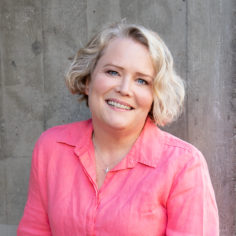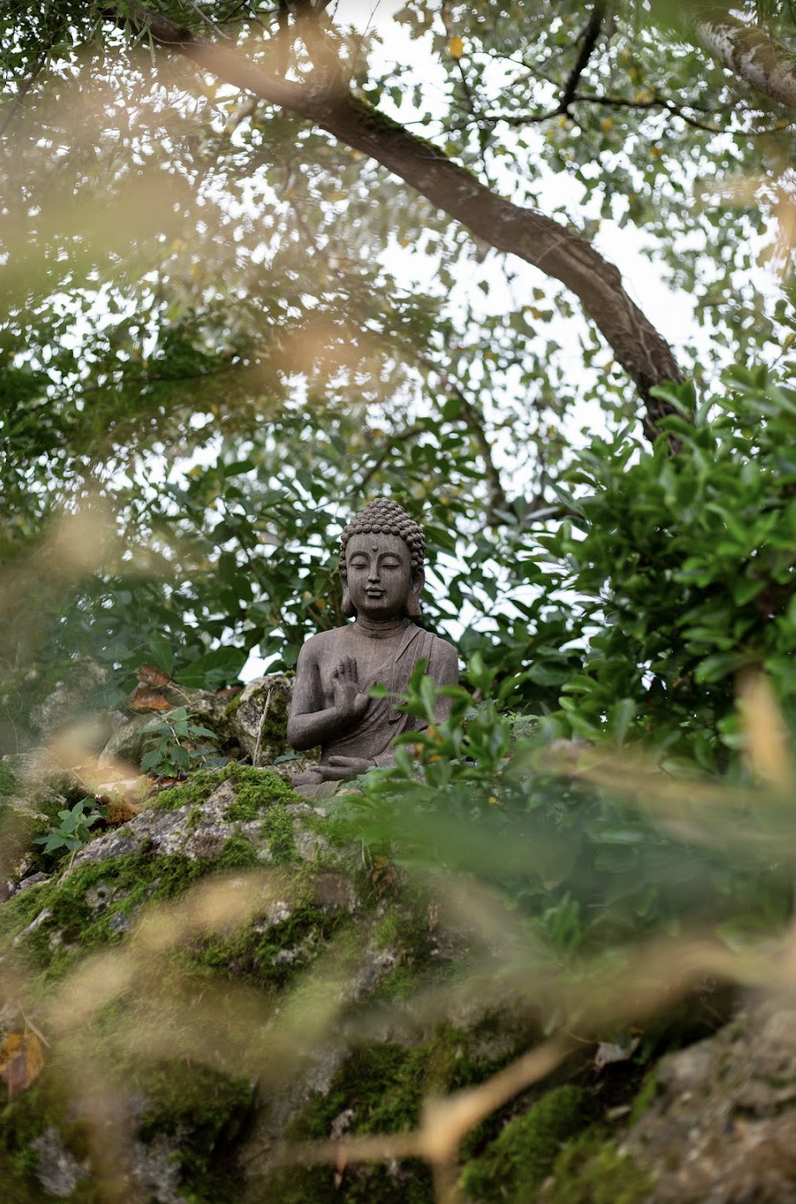By Orlaith O’Sullivan on
Anh-Le Ho-Gia is a lecturer at the National University of Singapore and co-founder of Happiness-based Education Schools. To celebrate the ninety-fifth continuation of Thích Nhất Hạnh, Orla and Anh-Le met to share about volition and developing happiness-based education in Central Vietnam.
Orla O’Sullivan: I’m so happy to have this opportunity to share together from our hearts.
By Orlaith O'Sullivan on
Anh-Le Ho-Gia is a lecturer at the National University of Singapore and co-founder of Happiness-based Education Schools. To celebrate the ninety-fifth continuation of Thích Nhất Hạnh, Orla and Anh-Le met to share about volition and developing happiness-based education in Central Vietnam.
Orla O'Sullivan: I’m so happy to have this opportunity to share together from our hearts.
Anh-Le Ho-Gia: Thank you so much for having me. I enjoy being with you and feeling connected.
OO: For me too. Maybe we can begin with the calligraphy behind you, “Happy teachers will change the world.” I remember your sharing that when you first saw the calligraphy, you were feeling some exhaustion and thought, “How can I be happy? And how can my being happy change anything?” Can you share about the beginning of your inspiration to do this work?
AH: Thank you for the question. I remember being in one of the Plum Village bookshops and seeing the calligraphy. I felt very touched. It was my first retreat in 2012. After working five years at a university in Singapore, I was stressed and burned out. I had lost interest in my work. Education has always been a calling from the heart for me. I came into education to create positive social change, but along the way I got lost, because I did not know how to take care of myself. I was a passionate teacher but not necessarily a happy one. When I saw the calligraphy I thought, “How can I be a happy teacher? How can I change the world through my being?” That was the first seed Thầy planted in me.
care for yourself, care for others, care for Mother Earth
OO: I think that experience is true for so many teachers. Many teachers give and give, and realise they have given too much for too long and haven’t taken time to take care of themselves. Seeing you so happy gives us a lot of hope!
AH: I learned my lesson the hard way. I wanted to give up. In Plum Village, I learned that self-care is the basis of all care. To become sustainable in a career as an educator, we really have to prioritize self-care. Plum Village was a healing journey for me—as a human, and a teacher, so I could heal myself and renew my aspiration. I received The Five Mindfulness Trainings and the name Luminous Compassion of the Heart.
Between 2012 and 2014 I practiced for myself mostly: practicing with sangha, going on retreats, and practicing on my own. After years of teaching, I accumulated a lot of tension, stress, and suffering in my body and heart. I took time to really allow the practice to sink in and to help transform me. My practice was to be, and I tried to bring my being into the classroom: the way I walk, how I listen—that was how I shared the practice. Then in 2014 I returned to Plum Village and listened to a panel on Wake Up Schools. I found my deepest aspiration—to help transform education.
OO: You returned to Singapore and shared the practice with students, colleagues, and others. Can you share about the catalyst that made you sense the urgency of supporting Central Vietnam?
AH: In 2016 there was heartbreaking news—a steel factory in Central Vietnam caused pollution that created massive marine life extinction in four provinces. I sensed despair, anger, frustration, and loss—we are children of the earth who live by the sea; our life depended on the sea. I kept asking, “What can we do?”
I brought that question with me to the 2016 winter retreat. I touched the earth, asking my spiritual ancestors, blood ancestors, and land ancestors: “What can I do?”
A seed was planted in me to start a school where we can plant other kinds of seeds: love, understanding, happiness, and peace. It occurred to me that for transformative education, I should plant the seeds as young as possible. In Vietnam, children attend preschool until seven years of age, so it’s a perfect environment. In July 2017 we opened our first school.
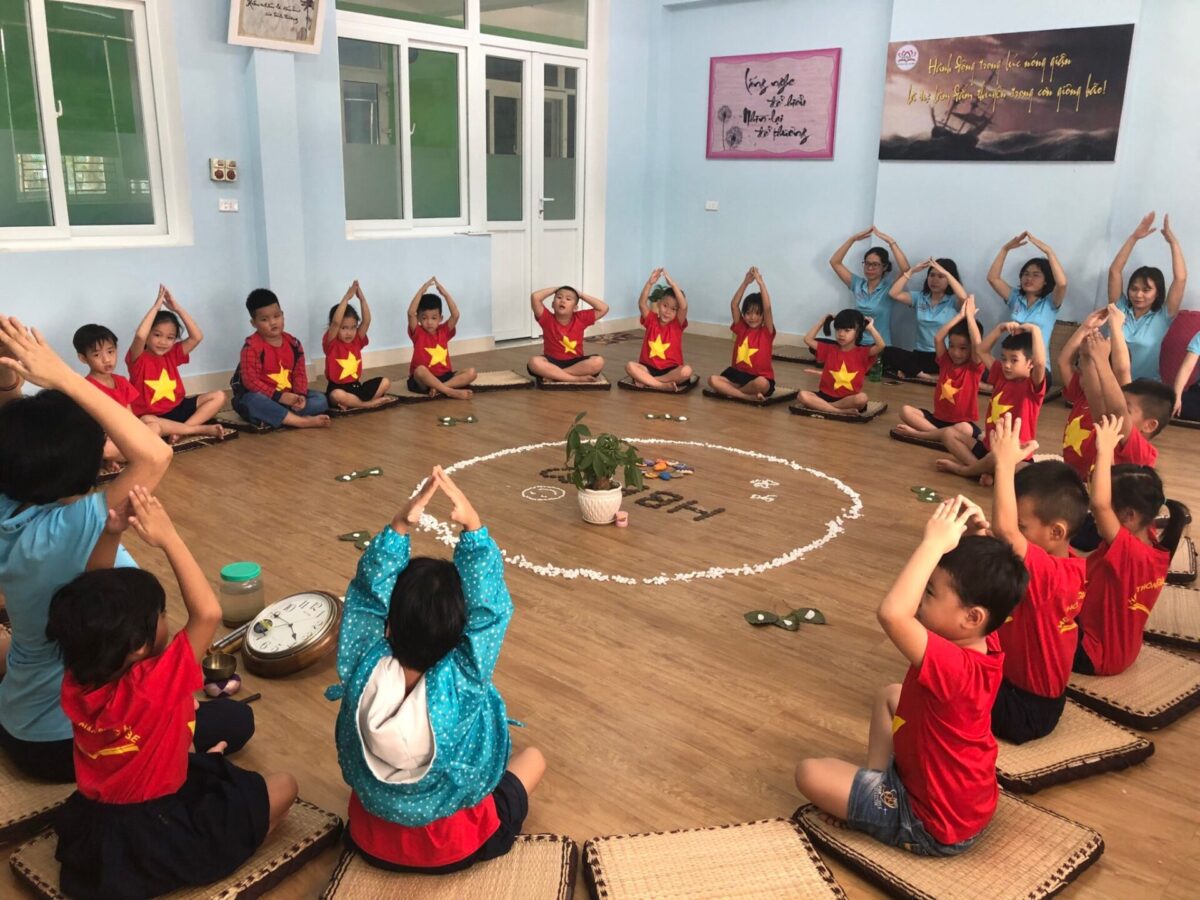
OO: That’s so quick!
AH: They say that when you have a deep aspiration from the heart, the universe will work to help it come true. [Laughter]
OO: Absolutely! It seems you were very skillful in introducing our loving mindfulness practice in a nonthreatening way, so it could be received and understood.
AH: Thank you for the encouragement; I really appreciate that. We wanted to make it easy for people to relate. We called our school a Lotus School—the lotus is Vietnam’s national flower, and we have many beautiful lotuses blooming in our hometown during the summer. We wanted our school to be a second home—a happy home—where children feel loved and understood. Our school would be a place to feel joy, peace, and deep connection.
I didn't mention anything about mindfulness or even social and emotional learning. Our first principles were: “Awakening the Source of Love” and “Nurturing the Seeds of Understanding.” The whole ecosystem was created with these in mind.
I learned from Thầy that the most important lesson in life is about love. Children can only learn about love when the teacher feels love in their heart. We had workshops and trainings for teachers, parents, and all the adults in the school, to help them to embody and teach love in every moment.
OO: Involving parents makes it very sustainable long-term. You have an exponential effect when the children can move between home and school, and both environments share the same language and commitment to practice. I know your schools have a very special connection with the earth and the environment - can you share your intention in planning the physical landscapes?
AH: We were very inspired by Joe Reilly’s song “I love nature.”
I love nature, Nature is cool. The forest is my classroom, The earth is my school. Trees are my teachers, Animals are our friends. And on this school All life depends.
I remember walking on the land with my father. We envisioned that in a few years there would be hills, trees, and lots of flowers. The children would sit under the trees, enjoying class outdoors. We really wanted to share that sense of space and connection with them.
The official English name for our school is “Happiness-based Education.” It is centered around the skills of happiness. Everyone in the school community practices mindfulness, happiness, and wellbeing. So that’s our main practice.
Our five guiding stars are:
- Every day at school is a happy day
- Awakening the source of love
- Nurturing the seeds of understanding
- Awakening creativity
- Nurturing talent
These remind us why we are here and why we have a school.
We also integrate the three circles of connection, inspired by Dharmācārya Ha-Vinh Tho and his Happy Schools project. The circles are: care for yourself, care for others, care for Mother Earth.
Caring for the earth is something special about these schools. When we designed them, we wanted the children to experience that they are part of the earth and the earth is us. The classes in different years are named after flowers, birds, trees and stars. We remind children that each of us is part of the cosmos and part of the earth. We are roses, we are an ocean, we are a rainbow, we are a star.
In each school we created a garden of love, with a path of happiness and a path of peace. Children walk barefoot, so they can feel their feet touch the earth. We have a stream of stillness where we can sit and see ourselves as still water reflecting. And we have hills of gratitude and understanding. There are many trees, including a bodhi tree, and a lotus pond. So everything reminds the children of the values we want to cultivate.
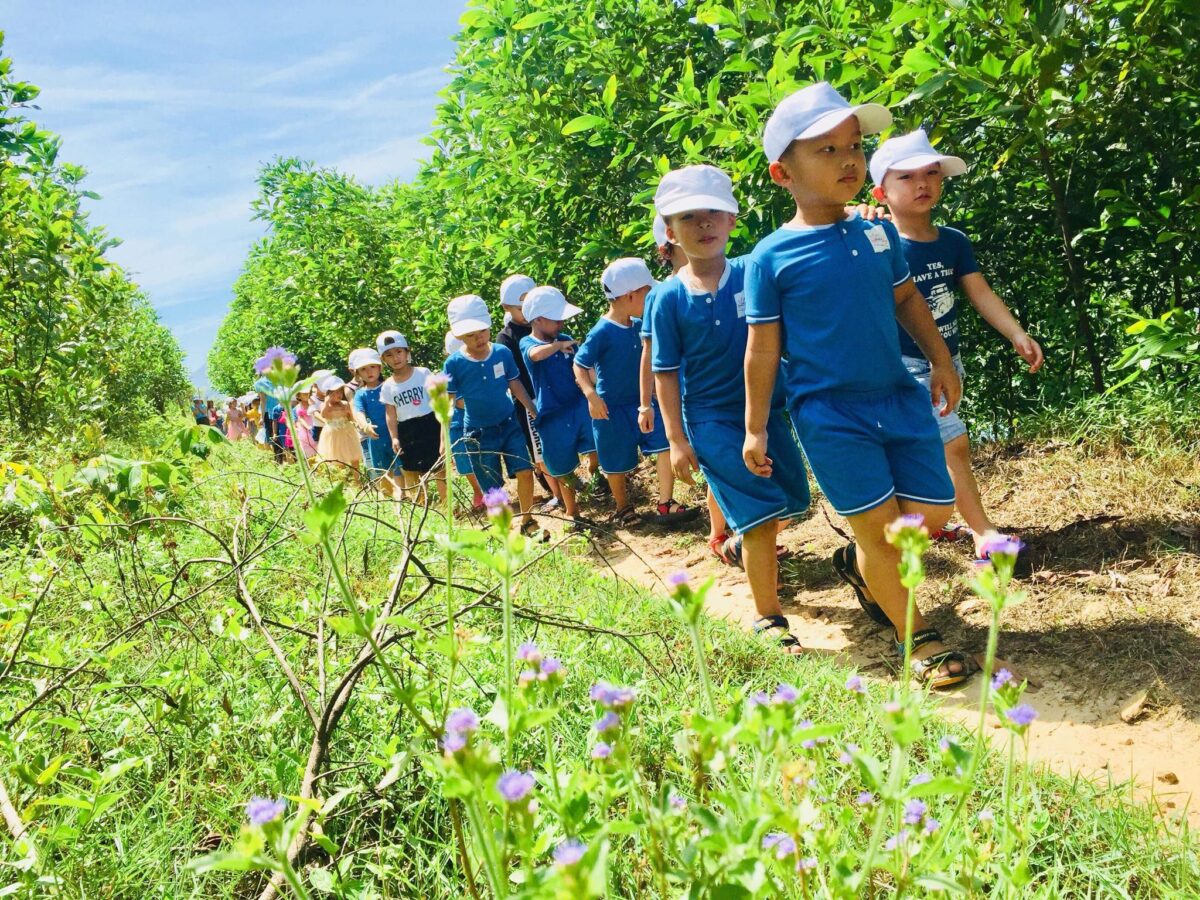
photo courtesy of Happiness-based Education Schools, Vietnam
Flowers became our first bell of mindfulness.
OO: That is so beautiful. I know you enjoy many practices: mindful walking between classrooms, mindful breathing, smiling, listening, mindful eating, deep relaxation, and gratitude. Can you share about how the bell has become part of your daily practice?
AH: In the beginning, I wasn’t sure how open parents would be towards mindfulness. We didn’t use the word mindfulness at all. Flowers became our first bell of mindfulness. When the children would walk around the garden, when they saw a flower they would stop, take three deep breaths, and smile. We are lucky to have a lot of birds, and they also became bells of mindfulness. Teachers taught the kids that when they heard a bird singing, they could stop, breathe, and thank the bird for the songs.
These days, we use the word “mindfulness,” and we have a school clock that chimes every hour. The whole school hears it, and everyone asks, “What am I doing?” It reminds us to breathe, smile, and be happy. We call it the messenger of peace.
In our school, children are very powerful teachers. They learn a lesson wholeheartedly, and when adults are forgetful, when they rush or aren’t enjoying a silent moment, the children remind them.
OO: You’re now four years into this work. I’m thinking back to the moment of the ecological disaster, which touched great despair and anger. You have grown such beautiful seeds from such a stark moment of suffering. It feels like good momentum is growing around Happiness-based Education. The Vietnamese government is interested in it. How does it feel to witness these seeds flourishing?
AH: When I look back, even though it's a very short journey, it has been the most transformative years of my life. I really experienced “no mud, no lotus.” I feel we’re learning from our ancestral teachers. For thousands of years, community has been the source of strength for Vietnam.
Planting these seeds wholeheartedly, we see rippling effects in the larger community. Children from public schools come to visit us and experience how it is to be in a happy school. That is the best outcome for me, when we can inspire others. I feel so moved by a video from when 250 children from a poor, public preschool visited our school one morning. Our students walked with them on the path of happiness, and they stood around the lotus pond singing, “Breathing in, breathing out.” When the clock chimed, they all put their hands on their bellies and breathed calmly and deeply. They looked so peaceful. At the end they smiled and waved their hands saying, “Happy!” I felt so touched. Even though it was a brief moment, they had touched peace deeply.
One of my favourite quotes is “A great teacher inspires.” Sharing kindness and love to inspire other schools is the most rewarding part of this project for me. I feel deeply grateful to all my blood, land, and spiritual ancestors, especially Thầy. He envisioned happy schools for so many decades, and now I have the opportunity to do something—or maybe not to do something—to be something!
OO: Thank you so much for your generosity and for your practice. It seems you have made a very good use of your suffering. As Thầy tells us, to suffer is not enough. We need to make really good use of our suffering. I feel you have made such beautiful use of your suffering. It has become a gift that ripped outwards and affects so many. Thank you, dear sister.
AH: Thank you so much.
You can watch their conversation on the Wake Up Schools YouTube channel. Edited by Leslie Rawls.
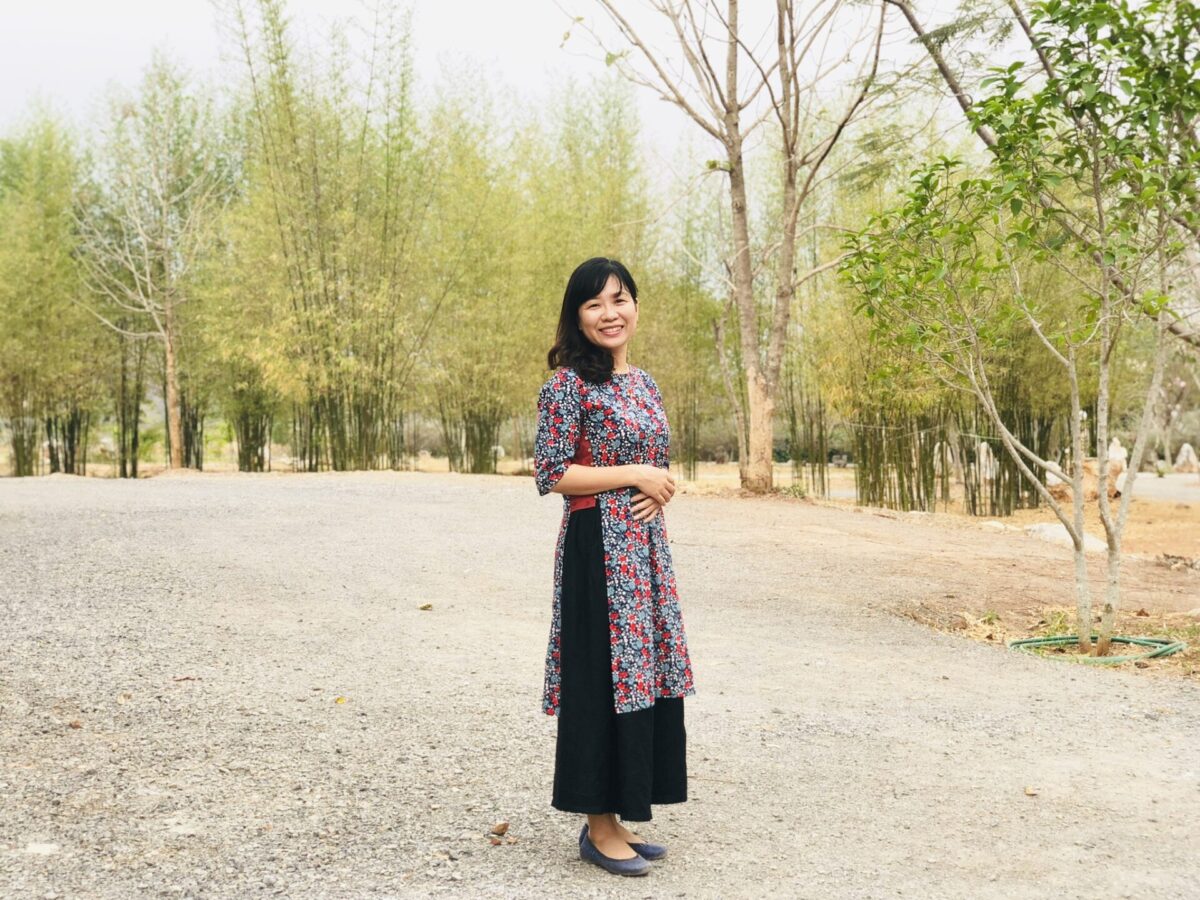
Anh-Le Ho-Gia, True Forest of Aspirations (pronouns she/her), received The Fourteen Mindfulness Trainings in 2014. She is passionate about bringing mindfulness into education to transform education.
